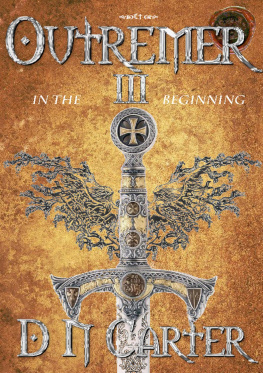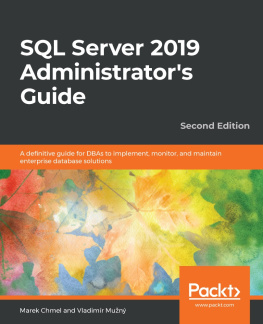1. T-SQL Techniques for DBAs
As a DBA, you will almost certainly understand the basics of the T-SQL language and use it for querying metadata views, such as sys.databases or sys.tables . Often, DBAs do not have advanced T-SQL skills, however, as they do not need them in day-to-day operations. In order to implement sophisticated automation and, in turn, reduce operational costs and overheads, DBAs should gain an understanding of some more advanced scripting techniques. Therefore, this chapter will focus on exploring some of the T-SQL techniques that we will use in this book. I will make the assumption that if you are reading this book, you are familiar with rudimentary T-SQL, such as the SELECT statement, including FROM , JOIN , WHERE , GROUP BY , HAVING , and ORDER BY clauses. If you do need a refresher, however, full details of the SELECT statement can be found at https://msdn.microsoft.com/en-us/library/ms189499.aspx # .
We will start by looking at the APPLY operator to call a function against rows within a result set. We will then look at how XML (eXtensible Markup Language) and how the native XML data type can be harnessed by SQL Server DBAs. It is critical for DBAs to have a handle on the use of XML, due to the volume of metrics and information that are exposed via this data type. We will then explore how to efficiently iterate through multiple objects.
Using the APPLY Operator
The T-SQL APPLY operator allows you to call a table valued function against every row in a result set returned by a query. There are two variations of the APPLY operator: CROSS APPLY and OUTER APPLY . When CROSS APPLY is used, the query will only return rows in which a result set has been produced by the table valued function. When OUTER APPLY is used, no filter will be applied to the result set, and where no result is returned by the table valued function, NULL will be returned, in each column of the table valued function.
The APPLY operator can be very useful to DBAs when they are retrieving metadata from dynamic management views (DMV) and functions (DMF). For example, the query in Listing will return a list of all sessions, detailing the session ID, the login time, the login name, and whether the process is a user or system process. It will then use OUTER APPLY to run the sys.dm_exec_sql_text dynamic management function against each row. This function returns a column called text, which is the SQL statement associated with the SQL handle in the sql_handle column in the sys.dm_exec_requests dynamic management view.
Note
The text column that is referenced in the SELECT list is the column returned by the sys.dm_exec_sql_text DMF.
SELECT s.session_id
,s.login_time
,s.login_name
,s.is_user_process
,[text]
FROM sys.dm_exec_sessions s
INNER JOIN sys.dm_exec_requests r
ON r.session_id = s.session_id
OUTER APPLY sys.dm_exec_sql_text(sql_handle) ;
Listing 1-1.
Using OUTER APPLY
You will notice that this query returns many rows in this result set with NULL values for the text column. This is because they are system processes, running background tasks for SQL Server, such as the Lazy Writer and the Ghost Cleanup Task.
Tip
We can be sure that they are system processes because of the is_user_process flag. We will not rely on the session ID being less than 50. The assertion that all system processes have a session ID of less than 50 is widely believed, but also a fallacy, because there can potentially be more than 50 system sessions running in parallel.
If we use the CROSS APPLY operator for the same query, as shown in Listing , the only rows that will be returned will be rows where the result of applying the tabled valued function is not NULL .
SELECT s.session_id
,s.login_time
,s.login_name
,[text]
,s.is_user_process
FROM sys.dm_exec_sessions s
INNER JOIN sys.dm_exec_requests r
ON r.session_id = s.session_id
CROSS APPLY sys.dm_exec_sql_text(sql_handle) ;
Understanding XML
XML is a markup language, similar to HTML, that was designed for the purpose of storing and transporting data. Like HTML, XML consists of tags. Unlike HTML, however, these tags are not predefined. Instead, they are defined by the document author. An XML document has a tree structure, beginning with a root node and containing child nodes (also known as child elements). Each element can contain data but also attributes. Each attribute can contain data that describes the element. For example, imagine that you require details of sales orders to be stored in XML format. It would be sensible to assume that each sales order would be stored in a separate element within the document. But what about sales order properties, such as order date, customer ID, product IDs, quantities, and prices? These pieces of information could either be stored as child elements of the sales order element, or they could be stored as attributes of the sales order element. There are no set rules for when you should use child elements or attributes to describe properties of an element. This choice is at the discretion of the document author. The XML document in Listing provides a sample XML document, which holds the details of sales orders for a fictional organization.
Listing 1-3.
Sales Orders Stored in an XML Document
There are several things to note when looking at this XML document. First, elements begin with the element name, encapsulated within angle brackets. They end with the element name, preceded by a backslash and enclosed in angle brackets. Any elements that fall between these two tags are child elements of the tag.
Attributes are enclosed in double quotation marks and reside within the beginning tag of an element. For example, OrderID is an attribute of the element .
It is acceptable to have repeating elements. You can see that is a repeating element, as two separate sales orders are stored in this XML document. The element is the documents root element and is the only element that is not allowed to be complex. This means that it cannot have attributes and cannot be repeating. Attributes can never repeat within an element. Therefore, if you require a node to repeat, you should use a nested element as opposed to an attribute.
The format of an XML document can be defined by an XSD schema. An XSD schema will define the documents structure, including data types, if complex types (complex elements) are allowed, and how many times an element must occur (or is limited to occurring) within a document. It also defines the sequence of elements. A full description of XSD schemas can be found at en.wikipedia.org/wiki/XML_Schema_(W3C) .
Tip
An XML document requires a root element in order to be well-formed. An XML document without a root element is known as an XML fragment. This is important, because it is not possible to bind an XML fragment to an XSD schema. This means that the structure of the document, including data types, cannot be enforced.
Converting Results Sets to XML
T-SQL allows you to convert relational results sets into XML, by using the FOR XML clause in your SELECT statement. There are four modes that can be used with the FOR XML clause: FOR XML RAW , FOR XML AUTO , FOR XML PATH , and FOR XML EXPLICIT . The following sections will demonstrate how the FOR XML clause works in RAW mode, AUTO mode, and PATH mode. EXPLICIT mode is beyond the scope of this book, as its functionality is very similar to PATH mode but is far more complex and does not often prove useful for DBAs.

















